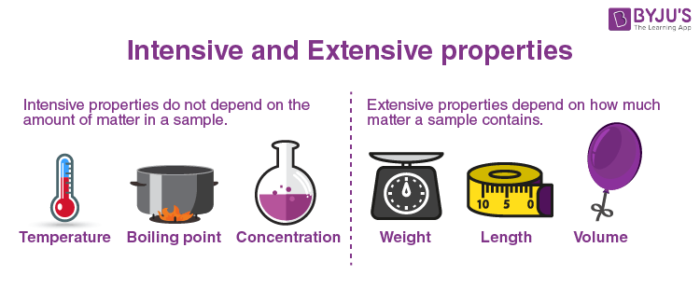What are Physical Properties?
A physical property is any measurable property whose value describes the state of a physical system. Changes in a system’s physical properties can be used to describe its transitions between momentary states. The measurement of physical property can alter the arrangement of matter in a sample but not its molecule structure. To put it another way, a physical property may involve a physical change but not a chemical change.
Table of Contents
- Intensive and Extensive properties
- Change in Physical properties lead to Physical Change
- Examples of physical properties
- How to measure Physical Properties
- Difference between physical and chemical properties
- Frequently Asked Questions- FAQs
Intensive and Extensive Properties
There are two types of physical properties: intensive properties and extensive properties.
Intensive properties: An intensive property is a bulk property, which means that it is a physical property of a system that is independent of system size or material content. Temperature, refractive index, density, and hardness of an object are examples of intensive properties.
For example- When a diamond is cut, the individual pieces retain their inherent hardness (until their size reaches a few atoms thick).
Extensive properties: For independent, non-interacting subsystems, an extensive property is additive. The property varies with the amount of material in the system.
The examples of extensive properties, such as mass and volume, are affected by the amount of matter measured.
Extensive properties are external, which means they cannot be used to identify the substance, and their value varies depending on the amount of the substance present. You can measure 10g of oil or 10g of water, for example, but this does not allow you to identify a substance as oil or water.

Read more: Intensive & Extensive Properties
Change in Physical Properties Leads to Physical Change
A physical change occurs without any changes in molecular composition. The same element or compound is present both before and after the change. Throughout the changes, the same molecule is present. Because some measurements necessitate changes, physical changes are linked to physical properties.
Some examples of physical changes are-
- Changes in state are an example of a type of physical change
- Changes in the state- changes from a solid to a liquid or a gas, and vice versa
- separation of a mixture
- physical deformation (cutting, denting, stretching)
- making solutions (special kinds of mixtures)
Examples of Physical Properties
Some examples of physical properties are:
- Area – the measurement of a two-dimensional surface in a plane.
- Boiling point – the temperature at which a liquid vaporises.
- Colour – the quality of an object or substance in terms of light reflected by the object, as measured visually by the hue, saturation, and brightness of the reflected light.
- Density – a substance’s mass per unit volume.
- Frequency – the number of repetitions in a given time period.
- Hardness – how resistant a solid matter is to external forces.
- Length – It is an object’s longest dimension.
- Mass – The amount of matter in an object is referred to as its mass.
- Melting Point – the temperature at which solid changes to a liquid.
- Odour – the scent of a substance.
- Pressure – the perpendicular force per unit area.
- Strength – The intensity or potency of a force or power.
- Temperature – a numerical measure of heat and cold.
- Volume – the amount of space that a substance takes up
- Weight – the amount of weight that an object has.
- Since all substances can exist in a solid, liquid, or gas phase depending on energy loss or gain, states of matter is also a physical property.
How to Measure Physical Properties?
All physical quantities must be measured. The value of a physical quantity can be expressed as the product of its numerical value and the unit in which it is expressed. The concept of significant figures is used to express the number’s accuracy. S.I. units are used to express measurement units.
Difference between Physical and Chemical Properties
Matter refers to everything we see and touch around us. Every matter has unique properties and characteristics that aid in classification and identification.
The primary distinction between Physical and Chemical Properties is that when a chemical reaction occurs on a substance, its molecular structure changes. Whereas a substance’s physical properties can be identified as its chemical composition and identity.
Read more: Difference between Physical and Chemical Properties
Recommended Videos
Matter Around us

Frequently Asked Questions on Physical Properties
What is a physical property?
A physical property is a property of matter that can be observed and measured without changing the sample’s chemical identity. Density, volume, size, colour, odour, etc., are some examples.
Can change in physical properties lead to chemical changes?
No, A physical change affects a substance’s physical properties, whereas a chemical change affects its chemical properties.
Define physical change.
It is a change in which the physical appearance or the physical properties of matter is altered but its composition remains unchanged. In a physical change, the same element or compound is present before and after the change. Throughout the changes, the same molecule is present.
Define extensive properties.
There are the physical properties of matter that depend on the quantity or size of the matter, such as length, mass, volume, weight, and so on. These properties of matter and their value change as the size or quantity of matter changes.
Can sublimation be considered a physical property?
Yes, sublimation can be considered as a physical property, because it is a physical change that occurs when a substance is heated and changes its state from solid to gas.
Comments